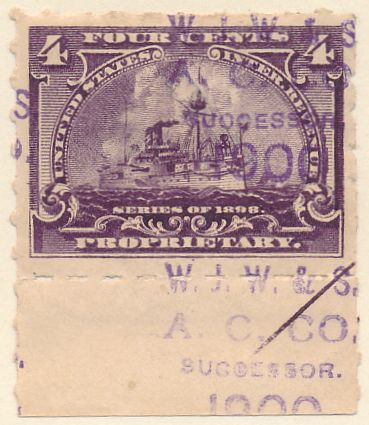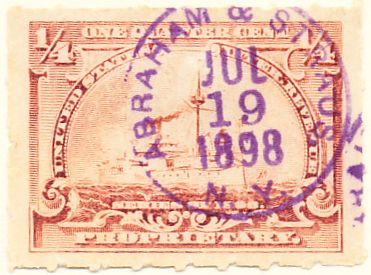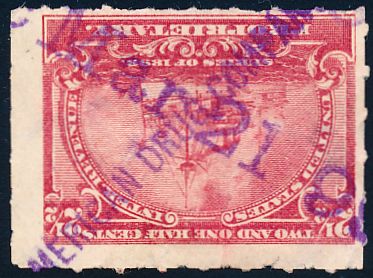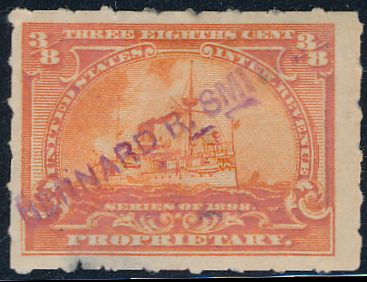Cancel Shorthand
General Format
According to the 1898 tax legislation, "in any and all cases where an adhesive stamp shall be used for denoting any tax imposed by this Act, except as hereinafter provided, the person using or affixing the same shall write or stamp thereupon the initials of his name and the date upon which the same shall be attached or used.." Most cancels follow this simple prescription, but many used their full names or a product name. Sometimes locations are also included.
The following general format is used in the BDR project to describe the precancels:
border or other formatting information, first line of the precancel/second line of the precancel/third line of the precancel/.../final line of the precancel, ink color and other miscellaneous information such as cancel placement on the stamp
The most common type of cancel is just initials and a date. These cancels are written out very simply using / for the start of a new line. The first line is usually the name and the date information is contained in an additional line or lines. Most cancels do not have borders, so there is no preceding border information. Cancels might use typefaces (e.g., fonts) with serifs (Roman style type such as Times Roman, for example), san-serif (e.g., Hevetica, Arial, or Universe), or other non-Roman we are simply calling "other."
The different features of this shorthand are described in the following sections.
Some revisions to the shorthand used in the original BDR print edition (1999) have been made for the online 2020-2023 BDR Project. Such changes are highlighted in the following tables with blue text.
Border Shorthand
| ( | Circle, typically the outer border of a circular date stamp; any precancel text immediately inside the outer border follows the circle symbol; a double space in this text (often between a name and a city or state) indicates a break in this text in which the remaining text starts in the opposite side of the circle in the opposite direction; there can also be a smaller circle within as shown in one example here (C.&H.Co. [s]BOSTON/yr,viol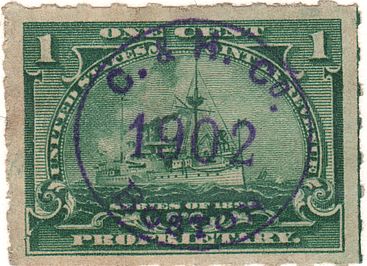 (BAER & BRO. VICKSBURG, MISS.(/mdy,blue 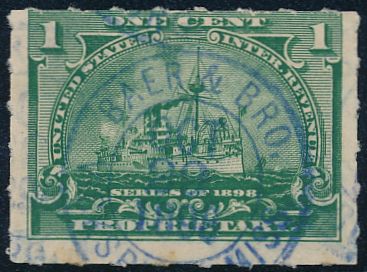 |
| (( | A pair of circles with the outer circle sometimes being bolder (([orn] FARBENWERKE [orn] HOCHST A/M./mdy,viol,blue,blk 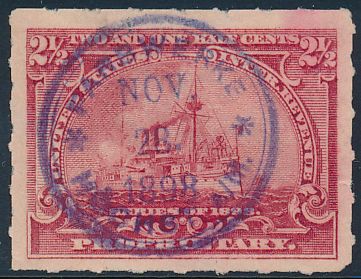 |
| o( | An oval variation of the circular border ( o(DOLLARD & CO. PHILADA./[s]yr,viol 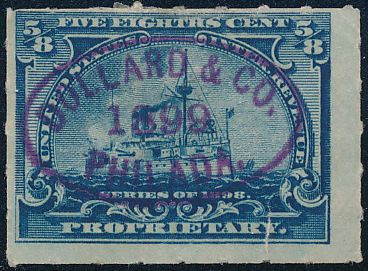 |
| gear( | A circular border with teeth gear([s]B.C.CO. PITTSFIELD,MASS./mdy,viol 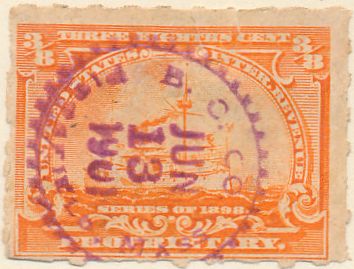 |
| bx | Rectangular border with following lines describing the precancel within the "box" bx,B.R.CO./yr,viol 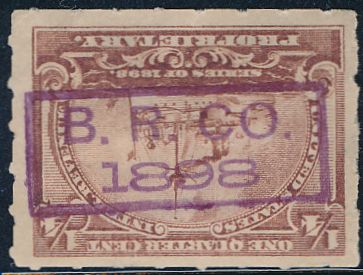 |
| wvy | Wavy as applied to a line or the edges of a rectangular border wvy bx,A.B.CO./date,blk 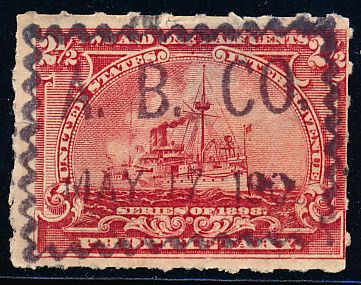 |
| hex | A six-sided border, often with a long side and square corners along the top hex,[s]A.P.F./mdy,blk,viol 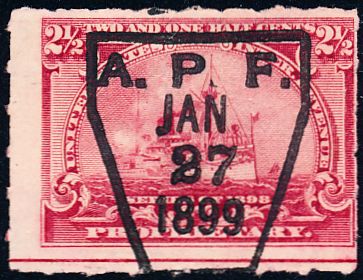 hex,A.P.P.,blk  |
| shield | A border, often with a point at the top, that curves inward down the sides to meet
at a point at the bottom. This typically resembles a military shield, and is a simpler border than
a shield which has a more complex top and overall shape. A typical shield design:  shield,[o]THE/[o]M.C.Co./[h 2mm]yr,blk,red [CJ type 2] 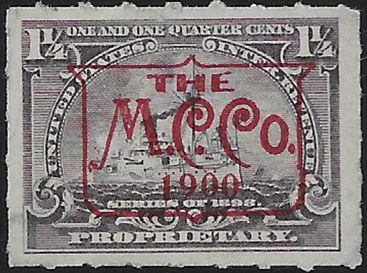 |
| badge | Cancels are sometimes bordered with the shape of a particular type of badge, more complex
than the shape of a shield. This shape has more curves along the top and sides. A representative badge of this design:  badge,bx[s]J.N.H.&Co.[or ;]/[s]L't'd./date,viol 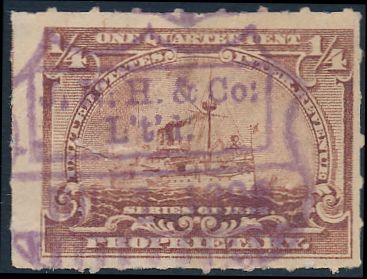 dbl ln badge,[s,a]J.W.&CO./mdy/[s,ra]PROV.R.I,viol,vert 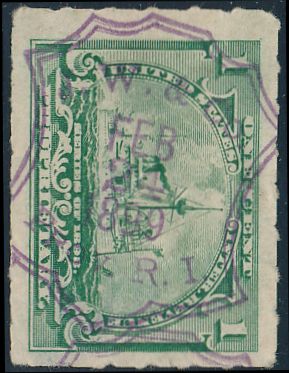 |
| [x]bx | A box border consisting of light-field X’s, often in pairs of X's [x]bx,[s]B.P.Co./mdy,viol,vert 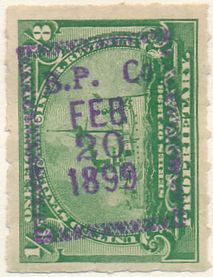 |
| fcy | A fancy type of border design fcy bx,[sm,i]CANCELED/mo/yr/[sm,i]C.A.F.&Co.,blk 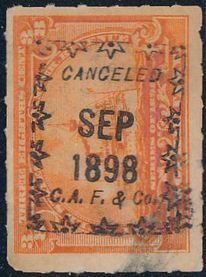 |
Cancel Format Shorthand
| : | Descriptors preceding this colon in [ ] apply to all following lines of the cancel until described to the contrary [s] :A.C.M.&CO./Mon dd,'yy,/Baltimore, Md.,blk,purple [CJ type 1] 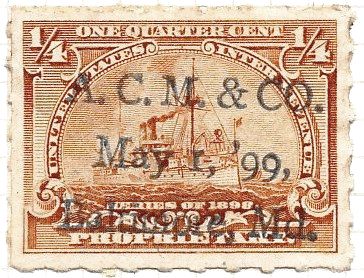 |
| / | Separates lines; indicates the start of a new line [s]:A.&A. /mo dd /yr,viol 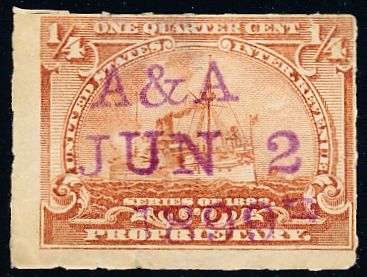 |
| dbl: | A combination of two cancels; each is individually described in full with the descriptions separated
by a semicolon; typically, the ink color is the same for both cancels, but more than one color can be noted if the two cancels
differ in color or type dbl:[w 16mm]A.W./yr;date,blk 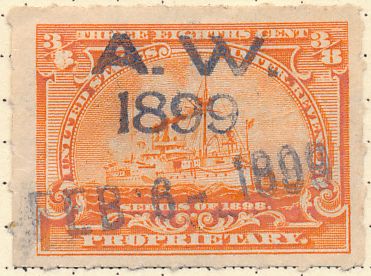 |
| [hs] | A handstamped line follows; since handstamping is the default, this can appear when a cancel denoted
in the index as a printed cancel includes a handstamped line such as a date dbl:[s]A.A.H.&Co.,blk; [hs]date,viol [CJ type 1] 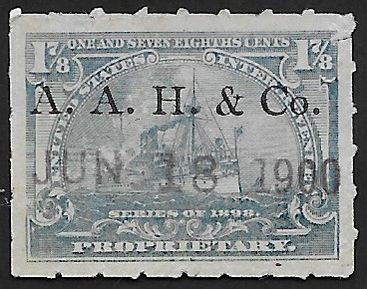 |
| [a] | Convex arching text [a]INTERNATIONAL FOOD CO./yr,red [CJ type 1] 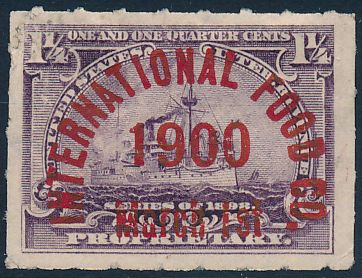 |
| [ra] | Concave arching text (or a "reversed arch") [s,a]C.B/[s]mdy/ [ra]NEW YORK,blk 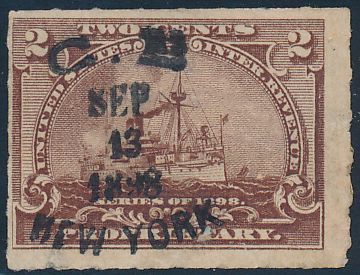 |
| [bar] | A solid bar [s]E.R.S./ [bar]/[lhs][star]mdy[rhs][star]/ [bar],viol 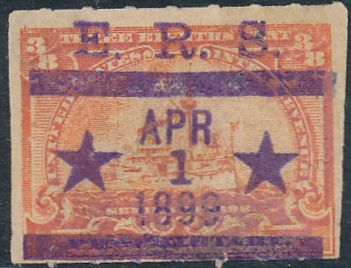 |
| [ln] | A line, usually horizontal unless otherwise indicated [ln]/[s]CLEANORA/ [ln]/[s]yr.,blue  |
| [orn] | A symbol or decorative ornament (E.H.F.&CO. [orn]/yr,viol 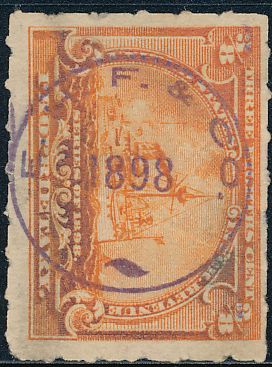 [orn][s]:DINER [orn]/[star]yr [orn],blk,viol  octagon,F.H.H./ [orn][s]yr [orn]/NEW YORK,blk 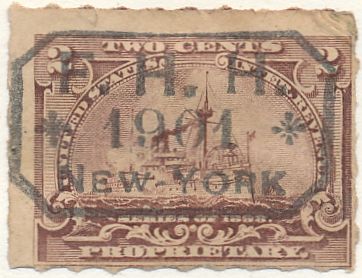 ([s]H.D.S.Co. yr(/ [orn],viol 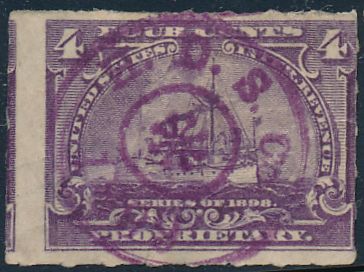 |
| [vert] | The following features run up and down such as text or lines [lhs, vert][alligator][mid,s]:Dr./E.A.H./ [vert]yr/Chas./S.C./[rhs, vert][s]LINIMENT.,viol,vert 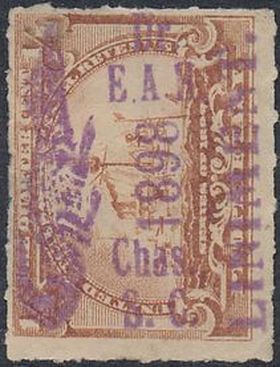 |
| [mid] (or [high] or [low]) | At an approximate middle height (or [high] or [low] position within the cancel) [4 wvy ln][bx]mo/[mid]yr[4 wvy ln]/[s]HENRY THAYER & CO.,viol,blk 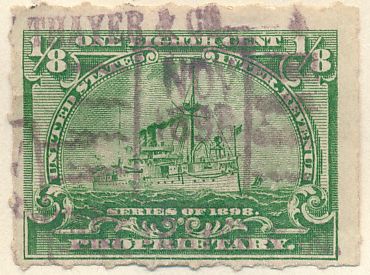 [s]:[lhs,vert]F.H.BUSHWAY[high]FLAVORING[rhs,vert] EXTRACT[low]Decatur,IIl./mdy,viol 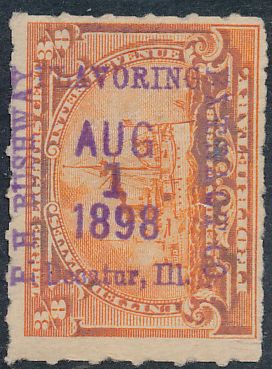 |
| [rhs] | Right hand side [sm]:C.D.S.D.CO./ [rhs]yr,viol 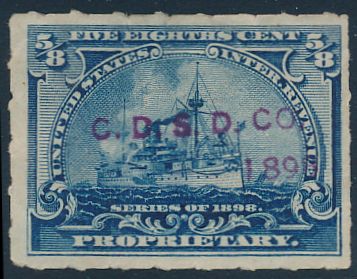 |
| [lhs] | Left hand side [s]E.R.S./[bar]/ [lhs][star]mdy[rhs][star]/[bar],viol  |
| [dot] | A dot, typically mid letter height distinguishing it from a common period B [dot]R [dot]W [dot]/yr,red 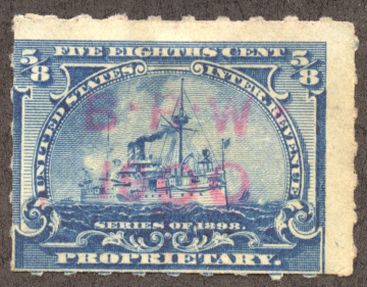 |
| [/] | An actual slash mark used in the cancel, in brackets to distinguish from a line break [lg,s]:G.W.S./mm[/]dd-yy,viol 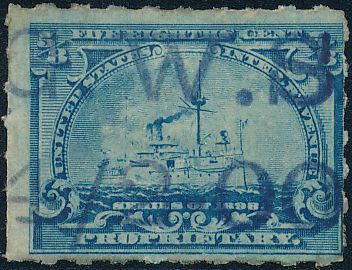 [s]C.P.Med.Co/mm[/]dd[/]'yy,blk [CJ unlisted] 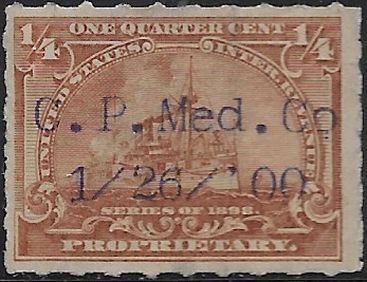 |
| [m xx] | Manuscript xx, where xx is typically a date or a year [s]A.F.Azmann,viol,[m date] 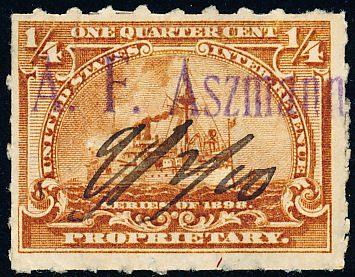 |
| [w xxmm] | The lettering in following line, EXCLUDING any trailing punctuation, has a width of xx millimeters; this may occasionally be included to help differentiate very similar cancels. Trailing punctuation is not included because this can sometimes be difficult to see with weak stampings. The variance of the width of a typical hand stamped cancel is approximately 0.5 mm or less for decent stampings, and appears in many cases to vary with the amount of inking. Measurements have been avoided with smeared, distorted, or poor stampings. Printed cancels tend to have sharper edges, less ink "squeeze," and are sometimes estimated to the nearest quarter mm for heights in sources like the Chappell-Joyce reference. A convenient and recommended tool for easily measuring cancel dimensions in electronic images is the XnView software. An image can be easily rotated (Shift+O) to get the cancel visually level in the image, and then a box can be dragged to surround the cancel using the left mouse button. The dimensions of this box are shown in the bottom of the screen. Divide the box width by the image resolution (e.g., 300 dpi) and this is the width in inches. Multiply by 25.4 to get the width in mm. [w 24.5mm]A.S.O./date,viol 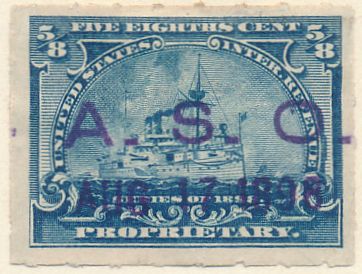 |
| [h xxmm] | The lettering in following line has a height of xx millimeters; this may occasionally be included to help differentiate very similar cancels. As mentioned above, the Chappell-Joyce listings sometimes estimate printed letter heights to the nearest quarter mm. [s]:[h 3mm]D&CO/[h 2mm]yr,blk [CJ type 4] 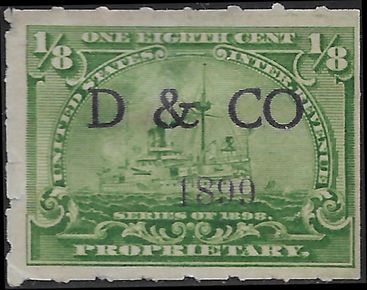 |
Typeface/Lettering Shorthand
| [s] | Lettering having serifs (e.g., most typically a Roman style such as "Times Roman"). The original BDR followed the Chappell-Joyce listings approach to describe printing fonts as primarily either "plain block type" or "serif." (Based on the widespread use of computer software for digital typography, the original BDR used the more familiar term of "sans serif" in place of "plain block type". This is described further in the next descriptor [ss] for sans serif.) Fonts, in the terminology of the Chappell-Joyce listings, are a scalable typeface for typography (the art and technique of arranging type for readability and appeal). The [s], or serif, fonts of Chappell-Joyce listings refer largely to "Roman" style lettering. ("Lettering" is an umbrella term for the art of drawing or creating letters, which in the case of hand stamps can be broader than the use of common typographic fonts.) In the recent online BDR project, [s] is used to describe any lettering which has the "Roman" style as its foundation. When a letter is viewed as individual pen strokes, these strokes are the "elements" of the letter. Roman lettering consists of thick and thin elements, and curved elements usually have a changing thickness (e.g., compare the thick sides of an 'O' with the thin top and bottom). Thickening of elements near their ends is also a feature of the serif (Roman) type [s]. Many cancels with Roman lettering having exaggerated differences in thickness were classified as a generic "calligraphic," or [c], type in the original BDR, but these are now simply included in the Roman typefaces designated [s] in the online BDR, and a new type [o] for other has introduced for lettering that is not [s] or [ss] (see below). [s]A.J.B./date/[s]CHICAGO.,viol 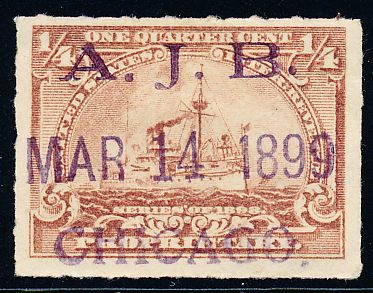 [s]A.H.CO./date/[sm,s]Waterbury,Ct.,viol 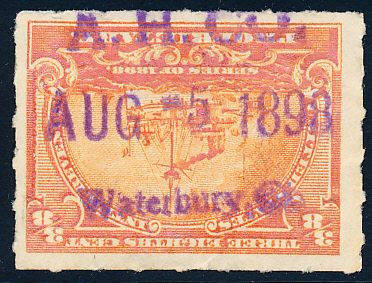 |
| [ss] | Cancel lettering not having serifs (sans serif) (e.g., a "Helvetica" or "Universe" style typeface); note that this is
the default typeface in the onlineBDR2, as it was in the original BDR. An important feature in this group of lettering styles is that elements of the lettering typically have a uniform thickness.
Because this is the default lettering description, [ss] appears only in cancels to describe a change in lettering to [ss], most often following [s] lettering. ([s]AUGUST LU[umlaut]CHOW [ss]NEW YORK/mdy,blk  |
| [o] | "Other" lettering types than the serif or sans serif(default) groups described above. These are based on artistic lettering or cursive writing styles other than Roman style lettering. [o]A.C.CO./mdy/[s]NEW YORK.,viol,vert 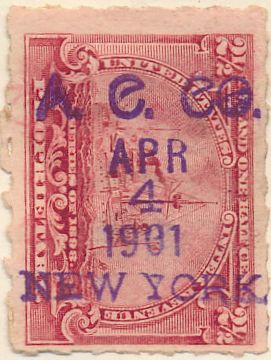 [o]Griffith,viol  [o]A&Co/yr,viol 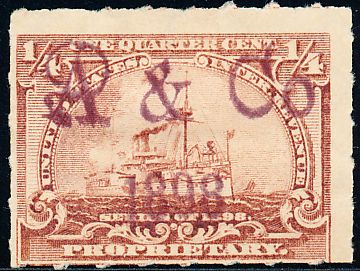 [o]:Miner/Toiletine, Etc./yr,blk [CJ unlisted] 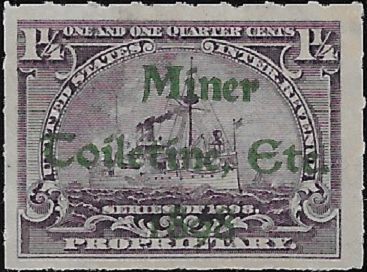 [o]C.A.Taggard,/yr,blk  |
| [i] | Italic [i]CANCELLED/date/[s]:A.F.&Co.,viol 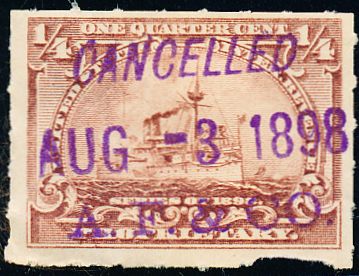 ([s]Disinfectine Co. Canton,O./[i]yr,blk,viol 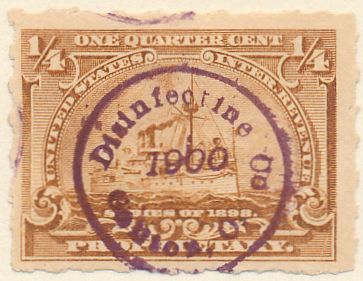 |
| [sm] | Lettering of small size W.J.W.&S./A.C.CO./[sm]SUCCESSOR./yr,viol
|
| [lg] | Lettering of large size [lg]B.&S./date,viol 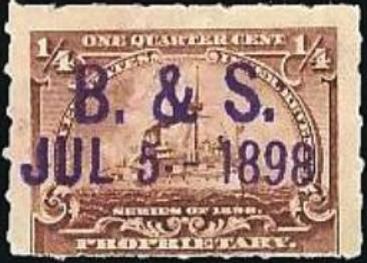 |
| [r] | An ending of the feature that was last indicated showing a return to the prior features 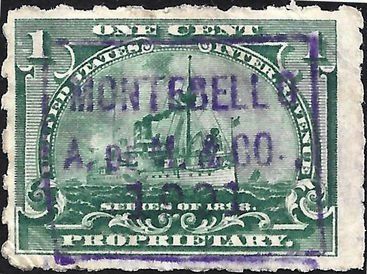 [s]:A.M[sup]c[r]K&SON./yr,blk 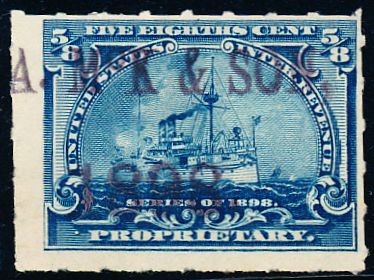 |
| [b] | Bold lettering [b]B.M.R./date,viol 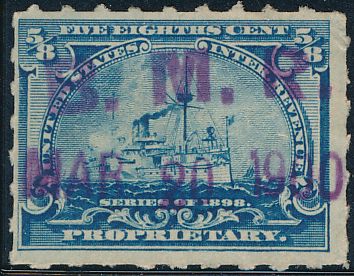 |
| [tall] | Lettering which is vertically elongated relative to stamps having otherwise similar cancel descriptions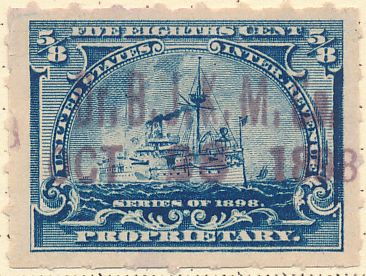 |
| [narrow] | Narrow spacing between letters [s]:CWJHH/[narrow,raised]Mon [r]dd yr,blk [CJ unlisted] 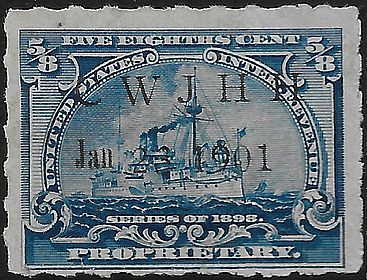 ?[w 19mm]G.[narrow]B[r]Co./date,blue 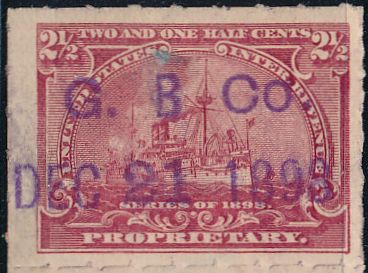 |
| [sup] | Superscript [s]:C.M.Co.[sup](Cd.)/yr,viol,1.5x [JC type 2] 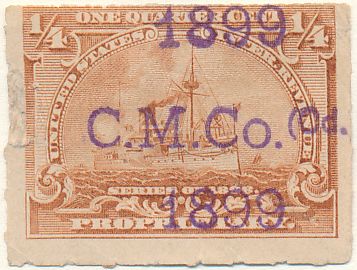 |
| [und] | Underline [s]:G.B.&C[sup,und]o/[sm]yr,blk 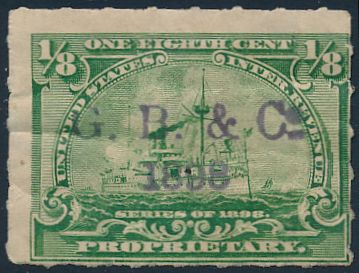 |
| [raised] (or [lowered]) | Raised toward the top of the stamp relative to the other characters in the line (or lowered for opposite displacement) [s]:D[raised]r[r]BCDCO/Mon dd yy,viol 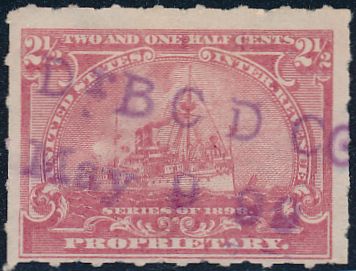 |
Date Shorthand
| mo | The month represented by the first three letters, usually all capitals and sans serif [s]:A.&A./mo dd/yr,viol  |
| dd | The date of the month as digits [s]:A.&A./mo dd/yr,viol  |
| yr | The year represented as four digits [s]:A.&A./mo dd/yr,viol  |
| date | The date written as a single line in the form mo dd yr; this is one of the most common forms in which
the date is used in cancels [s]A.&G./date,viol 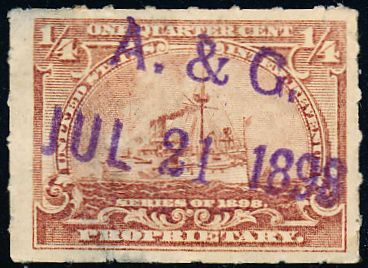 |
| mdy | A common combination in circular date stamps in which the month, the date and the year are on three separate lines in this order; the month is usually capital letters sans serif and only the first three letters are used; the date is one or two digits; and the year is four digits; this is a short form for the following representation: mo/dd/yr (ABRAHAM & STRAUS N.Y./mdy,viol
|
| dmy | A reordering variation of mdy ((DR.H.ASTHALTER, Pittsburg,Pa./dmy,blue 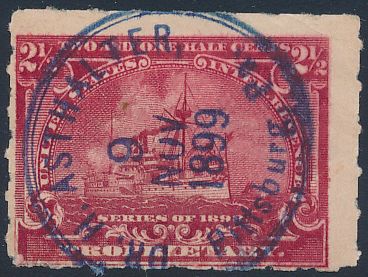 |
| mm | The month of the year represented as two digits A.E.W./mm-[sm]dd-yr,blk 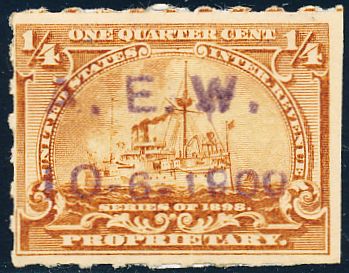 |
| yy | The last two digits of the year [s]:A.C.M.&CO./Mon dd,'yy,/Baltimore, Md.,blk,purple [CJ type 1]  |
| Mon | The month represented by the first three letters, the first capitalized and the second and third letters
in lower case [s]:A.C.M.&CO./Mon dd,'yy,/Baltimore, Md.,blk,purple [CJ type 1]  |
| Mont | The month spelled using the first 4 letters, first letter capitalized [s]:B.S.Co./Mont. yy,viol 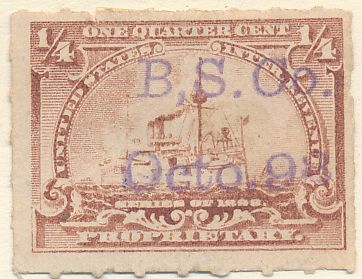
|
| MONT | The month spelled using the first 4 letters, all capital letters A.S.H./[sm,s]MON.[or MONT.] dd,yr.,blk [CJ type 2] 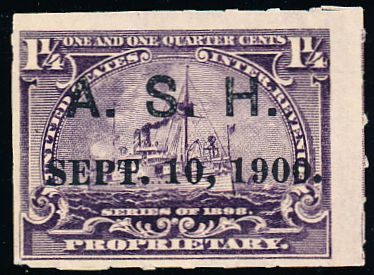
|
| Month | The month fully spelled with only the first letter capitalized [s]:BO&GCW/Month dd,yr,blk 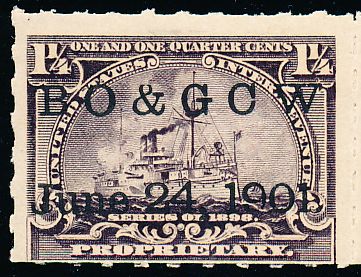 [s]C.E.C./Month, yr.,blk 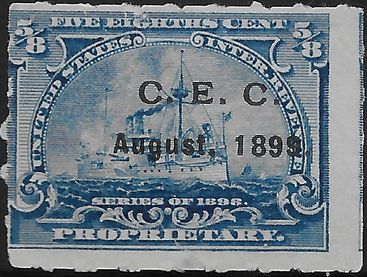 [s]:C.W.&CO.Month dd,y.,blk [CJ type 2] 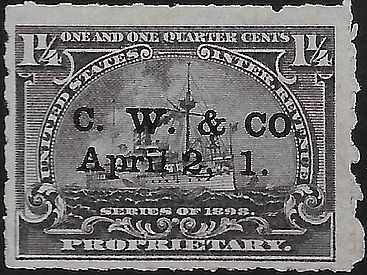 [s]:E.F.&CO.,/Month,/yr.,blk [CJ type 2] 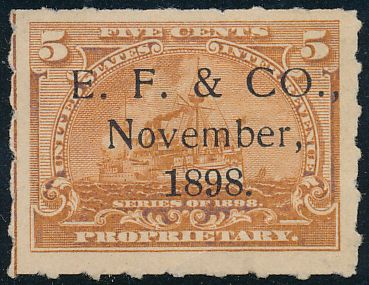 |
| MONTH | The month fully spelled out in all capital letters [sp2,s]:ABS/MONTH 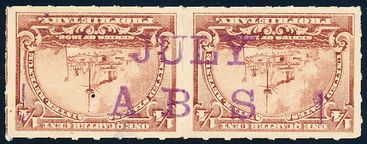 [w 19.5mm]CANCELLED,/MONTH yr,,blk 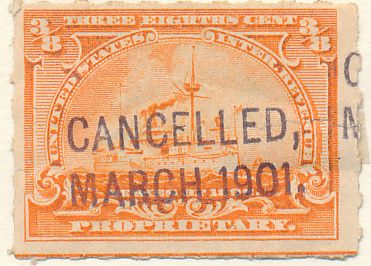 |
Ink Color Shorthand
| viol | Violet or purplish |
| blk | Black |
| red | Red |
| blue | Blue |
| grn | Green |
Miscellaneous Notations and Cancel Placement
| ? | A "?" leading the cancellation description indicates that the attribution of this specific cancel
with the company in the ERA Druggists Directory database is speculative ?A.B.H./date,viol 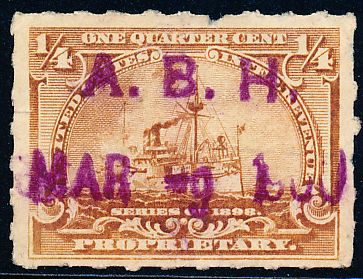 |
| [?] | A bracketed "?" following lettering or other information indicates a poor strike which
rendered the preceding character or a character thought to be in this position difficult to read A.H.H.&C[?]/date,blk 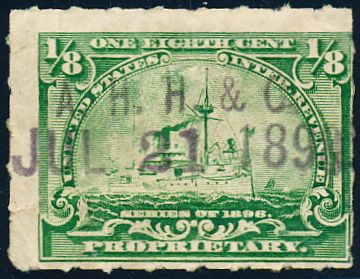 [s]:B.&D[?]../yr,blk 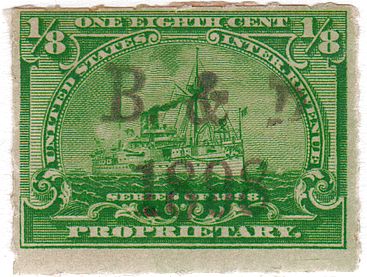 [s]CATTOEU[?]/date,blk  C.K.&C[sup,und]o/date[?],viol 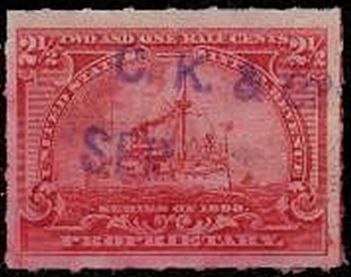 |
| ?? | A pair of question marks indicate a major feature such as a probable word or group of words in which
the strike is too difficult to read ((([fcy design]?? CONES ??,viol 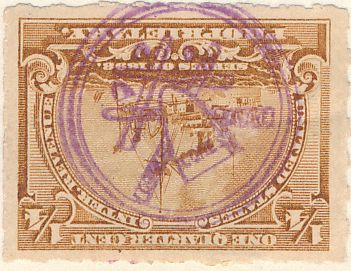 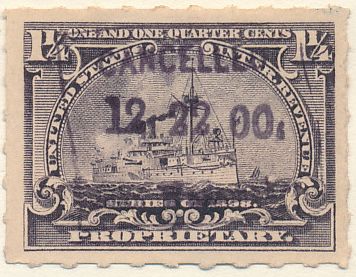 bx,[w 14mm]CANCELLED[sm sub]1/mm[sm sub]1 [r]dd. yy[upside down],/??,viol ?C.E.W./yr/??,blk (see CEWCo) 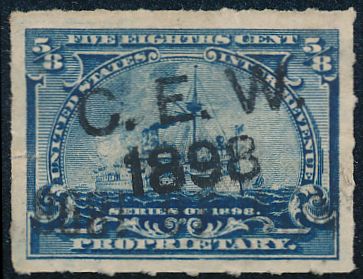 |
| .. | A pair of periods leading or ending a line of a cancel indicates that the lettering goes off the
stamp or the strike trails off too much to read; additional examples of these cancels are used to complete the knowledge of the specific lettering, especially with respect
to arriving at in index for inclusion in the listings D.O'DON../Phar../1st & C Sts..,viol 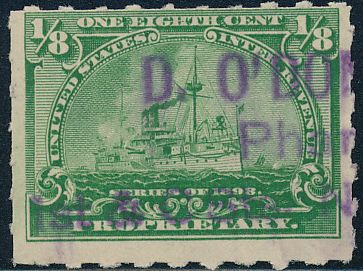 ([s]A.EISLER ..(/mdy,blk  |
| 1.5x, 2x, etc.. | This notation appended to a cancellation description indicates that the cancel is applied to a stamp multiple
times (e.g., two times or "2x"); the spacing between the repetitions of the cancel is often conserved indicating that
a large stamp having multiple coverage of each stamp was likely applied to a sheet or a rolled stamp was used. [w 13.5-14mm]C.M.CO./Mon.[or Mont] dd, yr,viol,blk,2x 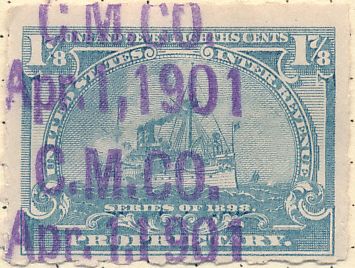 |
| [span n] | Cancel which spans n stamps [span 2,s]Annen Candy & Biscuit Co.,blk 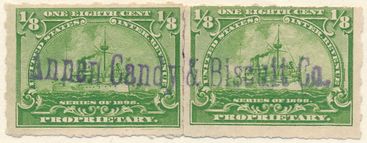 |
| diag | A diagonally oriented cancel; this term is reserved for cancels that appear to be consistently and deliberately stamped in a strongly diagonal rotation; this is not to be confused with a moderate amount of imprecision normally associated with handstamped cancels dbl:AMERICAN DRUG COMPANY,diag;date,diag,viol
|
| mdiag | Mostly diagonal in that most of the known cancels have the following features diagonal BERNARD R. SMITH,viol,mdiag
|
| vert | A descriptor near the end of a
cancel description to indicate the entire orientation of the cancel as vertical; dbl fcy bx,[s]A. & Sons Co./mdy,red,vert 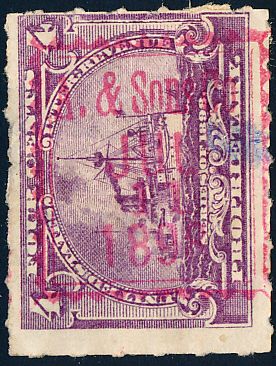 |
| mhoriz | Some vertical cancel orientations are known, but most are horizontal
|
| [CJ type n] | A descriptor at the end of a cancel description showing the Chappell-Joyce cancel type according to their 1957 listing of proprietary
battleship cancels; their listing is primarily printed cancels, but does include some hand stamped cancels; a reference of "1" in the source column
indicates the cancel description and known denominations are taken from their listing; printed cancels not in the CJ listings are noted as CJ unlisted [s]:C.W.&CO.Month dd,y.,blk [CJ type 2]  |
